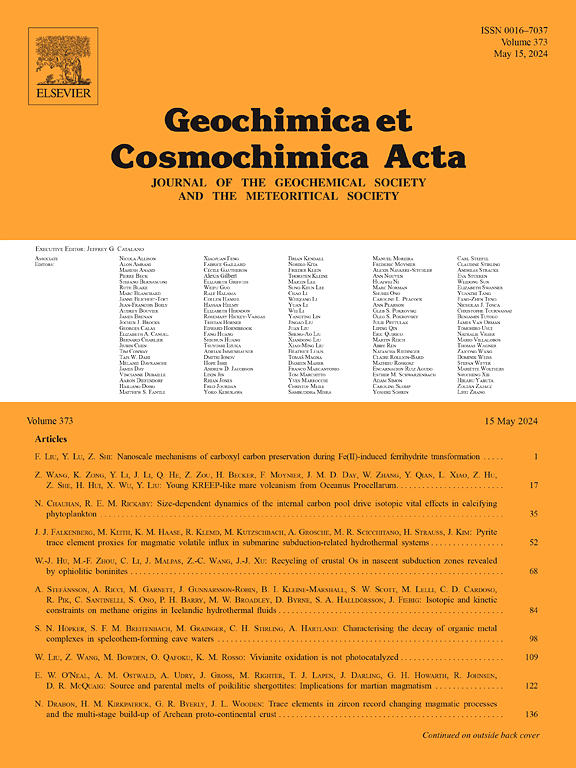确定磁铁矿中微量元素和次要元素的含量作为磁生细菌的生物特征
IF 4.5
1区 地球科学
Q1 GEOCHEMISTRY & GEOPHYSICS
引用次数: 0
摘要
引磁细菌(MTB)以基因控制的方式产生细胞内磁铁矿(Fe3O4)纳米颗粒。它们可能是地质记录中最古老的生物矿化生物,但对其化石的鉴定仍存在很大争议。有机分子会在成岩和变质过程中降解,而 MTB 磁铁矿纳米晶体却能有效地保存在岩石记录中,被称为磁化石。对淡水细菌 Magnetospirillum magneticum 菌株 AMB-1 的实验研究表明,其特定的微量元素和痕量元素模式与非生物磁铁矿的模式截然不同,并建议将其作为磁化石鉴定的工具。这些有前景的地球化学特征需要在不同的 MTB 菌株中得到验证,才能用于古生物重建。在此,我们在不同的化学条件下培养了一种海洋 MTB(Magnetovibrio blakemorei 菌株 MV-1),以测试这种新替代品的通用性。MV-1 以抗坏血酸铁(II)或柠檬酸铁(III)为铁源,在不同的铁浓度(50、100 和 150 μM)和氧化还原状态下生长。通过 ICP-MS 分析确定了生长介质和提取的磁铁矿晶体的化学成分,以量化磁铁矿和溶液之间的痕量元素和次要元素分配。结果表明,分区系数与铁的浓度和氧化还原状态没有一阶关系,这是可能应用于自然系统的一个重要结论。对两种菌株的比较表明,MV-1 磁铁矿的杂质浓度通常高于 AMB-1 磁铁矿。不过,一些元素具有相似的分配系数,可能是测试磁铁矿生物来源的有用化学代用指标。这些一致的元素可分为三组。第一组由 MTB 磁铁矿中相对于非生物磁铁矿高度贫化的元素(钴、锰、铅、锶)组成。第二组包含在 MTB 磁铁矿和非生物磁铁矿中分配相似的元素,包括 Ca 和 Li。这组元素可作为制约古流体成分的参考。最后一组包含的元素(钼、锡、硒)在 MTB 磁铁矿中相对于非生物磁铁矿富集。这种富集可能与这些元素的生物功能有关。因此,从实验室实验中确定的化学模式是在岩石记录中识别 MTB 磁铁矿的有希望的化学代用指标,但现在需要在现代自然环境中进行测试,因为在现代自然环境中可以共同收集 MTB 和周围的溶液。本文章由计算机程序翻译,如有差异,请以英文原文为准。
Establishing the content in trace and minor elements of magnetite as a biosignature of magnetotactic bacteria
Magnetotactic bacteria (MTB) produce intracellular magnetite (Fe3O4) nanoparticles in a genetically controlled manner. They may represent some of the oldest biomineralizing organisms available in the geological record, but identification of their fossils remains highly debated. While organic molecules are degraded during diagenesis and metamorphic processes, MTB magnetite nanocrystals can be efficiently preserved in the rock record and are referred to as magnetofossils. Experimental work on the freshwater bacterium Magnetospirillum magneticum strain AMB-1 has demonstrated specific minor and trace element patterns distinct from those of abiotic magnetite, and were proposed as a tool for magnetofossil identification. These promising geochemical signatures need to be validated in diverse MTB strains to be used for paleontological reconstruction. Here, we cultivated a marine MTB (Magnetovibrio blakemorei strain MV-1) under various chemical conditions to test possible generalization of this new proxy. MV-1 was grown under various Fe concentrations (50, 100 and 150 μM) and redox states using either Fe(II)-ascorbate or Fe(III)-citrate as Fe sources. The chemical compositions of the growth media and extracted magnetite crystals were determined by ICP-MS analyses to quantify the partitioning of trace and minor elements between magnetite and solution. Results show that partition coefficients do not depend at first order on the Fe concentration and redox state, a crucial conclusion for potential application to natural systems. A comparison of the two strains shows that MV-1 magnetite generally contains higher concentrations of impurities than AMB-1 magnetite. However, a number of elements possess similar partition coefficients and may represent useful chemical proxies for testing the biological origin of magnetite. These consistent elements can be separated into three groups. The first group is composed of elements (Co, Mn, Pb, Sr) highly depleted in MTB magnetite relative to abiotic magnetite. The second group contains elements with similar partitioning in MTB and abiotic magnetite, including Ca and Li. This group may serve as a reference for constraining a paleo-fluid composition. The last group contains elements (Mo, Sn, Se) enriched in MTB magnetite relative to abiotic magnetite. Such enrichments might be related to biological function of those elements. Chemical patterns determined from laboratory experiments therefore represent promising chemical proxies to identify MTB magnetite in the rock record but now need to be tested in modern natural environments, where MTB and surrounding solution can be jointly collected.
求助全文
通过发布文献求助,成功后即可免费获取论文全文。
去求助
来源期刊

Geochimica et Cosmochimica Acta
地学-地球化学与地球物理
CiteScore
9.60
自引率
14.00%
发文量
437
审稿时长
6 months
期刊介绍:
Geochimica et Cosmochimica Acta publishes research papers in a wide range of subjects in terrestrial geochemistry, meteoritics, and planetary geochemistry. The scope of the journal includes:
1). Physical chemistry of gases, aqueous solutions, glasses, and crystalline solids
2). Igneous and metamorphic petrology
3). Chemical processes in the atmosphere, hydrosphere, biosphere, and lithosphere of the Earth
4). Organic geochemistry
5). Isotope geochemistry
6). Meteoritics and meteorite impacts
7). Lunar science; and
8). Planetary geochemistry.
 求助内容:
求助内容: 应助结果提醒方式:
应助结果提醒方式:


